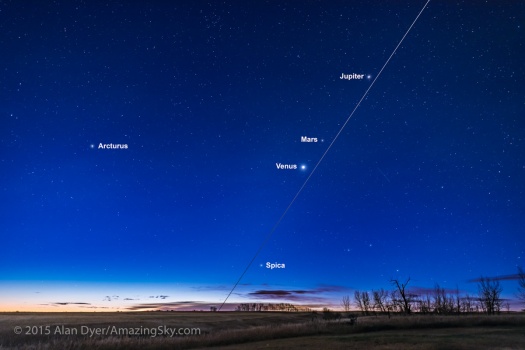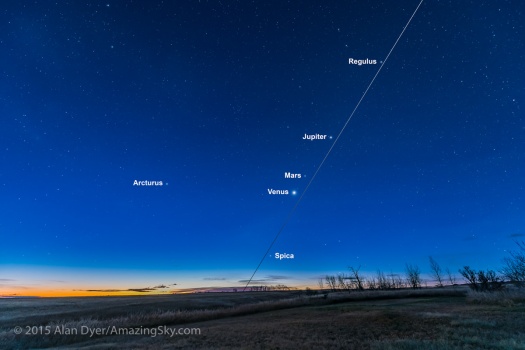The morning planets are now strung out along the ecliptic, visualizing this line in the sky.
This was the view this morning, November 14, of the three dawn planets lined up along the ecliptic, with the stars Spica and Regulus also defining this imaginary line.
The ecliptic is the Earth’s orbital path around the Sun projected into the sky. So it is along this line that we see the Sun appear to move around the sky over a year. But it is also the path along which we find the seven other major planets – in this case, three of them: Venus, Mars and Jupiter.
These three worlds were clustered together in October, but are now spreading out along the ecliptic, as Venus drops lower but Mars and Jupiter climb higher.
The stars Spica and Regulus also lie along the ecliptic, where the Moon can occasionally pass in front of, or occult, these stars.
So the two stars and three planets are now nicely drawing the ecliptic line for us in the dawn sky. At this time of year, the ecliptic is also steeply angled above the eastern horizon.
The main image above is a stack of 4 x 20 second exposures for the ground, to smooth noise, and one 20-second exposure for the sky, all with the Nikon D810a at ISO 1000 and Nikkor 14-24mm lens at f/2.8 and at 14mm.

This image just above is with the same gear but with the lens at the 24mm setting to more tightly frame the planets.
Meanwhile, on the other side of the sky at dawn, Orion and his winter sky friends were setting into the west (image below).

All the images here are shot with the Nikon D810a camera and the amazing Nikkor 14-24mm lens, two items in hand this month for testing and review. A thorough test will appear in future blogs.
Of course, as wonderful as the gear is, it cannot extract the ecliptic line and labels from the sky – those are added in Photoshop!
– Alan, November 14, 2015 / © 2015 Alan Dyer / amazingsky.com

